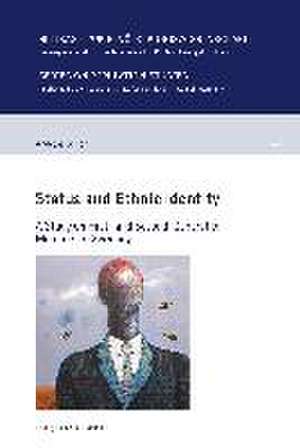Genoni, A: Status and Ethnic Identity: Beitrage zur Bevoelkerungswissenschaft
Autor Andreas Genonien Limba Engleză Hardback – 3 apr 2022
Preț: 255.92 lei
Nou
Puncte Express: 384
Preț estimativ în valută:
48.97€ • 51.27$ • 40.52£
48.97€ • 51.27$ • 40.52£
Carte disponibilă
Livrare economică 17-31 martie
Livrare express 28 februarie-06 martie pentru 36.14 lei
Preluare comenzi: 021 569.72.76
Specificații
ISBN-13: 9783847425755
ISBN-10: 3847425757
Pagini: 178
Dimensiuni: 177 x 242 x 20 mm
Greutate: 0.48 kg
Editura: Budrich
Seria Beitrage zur Bevoelkerungswissenschaft
ISBN-10: 3847425757
Pagini: 178
Dimensiuni: 177 x 242 x 20 mm
Greutate: 0.48 kg
Editura: Budrich
Seria Beitrage zur Bevoelkerungswissenschaft
Notă biografică
Andreas Genoni is a researcher in the Migration and Mobility Research Unit at the Federal Institute for Population Research, Wiesbaden, Germany.
Cuprins
I INTRODUCTION 1 The notion of ethnic identity
2 Studying ethnic identity
3 The role of status
4 Research interest
5 Outline of this book
II THEORETICAL FRAMEWORK
6 The two building blocks of social production function theory
6.1 Resources, goals, needs and utility: The hierarchy of social production functions
6.2 Maintaining and improving personal need satisfaction
7 Social production functions and context
8 A general model to explain migrants' ethnic identity
8.1 Individual resources
8.2 Contexts and their conditions
8.3 Need satisfaction of first- and second-generation migrants
8.4 Five underlying mechanisms of ethnic identification
8.5 Explaining migrants' ethnic identity
9 Summary
III DATA
10 The German National Educational Panel Study (NEPS)
10.1 Starting cohort (SC) 6
10.2 The sample
IV EMPIRICAL INVESTIGATION
11 A short note on multinomial logistic regression analysis
12 Analysis 1: Status and ethnic identity: The role of generation status and migrant recognisability
12.1 An intergenerational perspective on status and ethnic identity
12.2 The role of migrant recognisability
12.3 Model specification and analytical strategy
12.4 Findings
12.5 Discussion
13 Analysis 2: Status mismatch and ethnic identity
13.1 Theoretical considerations and expectations
13.2 Model specification and analytical strategy
13.3 Findings
13.4 Discussion
14 Analysis 3: Exposure time, ethnic identity and the role of status
14.1 An intergenerational perspective on exposure time and ethnic identity
14.2 Cumulative (dis)advantages? Identity differences between lower- and higher-status migrants over exposure time
14.3 Model specification and analytical strategy
14.4 Findings
14.5 Discussion
V CONCLUDING REMARKS
15 Limitations
16 Main results
17 Future avenues
REFERENCES
APPENDIX
A Variable overview
a. Dependent variable
b. Explaining variables
c. Other variables
d. Dealing with missingness: Multiple imputation with chained equations
B Additional analyses
2 Studying ethnic identity
3 The role of status
4 Research interest
5 Outline of this book
II THEORETICAL FRAMEWORK
6 The two building blocks of social production function theory
6.1 Resources, goals, needs and utility: The hierarchy of social production functions
6.2 Maintaining and improving personal need satisfaction
7 Social production functions and context
8 A general model to explain migrants' ethnic identity
8.1 Individual resources
8.2 Contexts and their conditions
8.3 Need satisfaction of first- and second-generation migrants
8.4 Five underlying mechanisms of ethnic identification
8.5 Explaining migrants' ethnic identity
9 Summary
III DATA
10 The German National Educational Panel Study (NEPS)
10.1 Starting cohort (SC) 6
10.2 The sample
IV EMPIRICAL INVESTIGATION
11 A short note on multinomial logistic regression analysis
12 Analysis 1: Status and ethnic identity: The role of generation status and migrant recognisability
12.1 An intergenerational perspective on status and ethnic identity
12.2 The role of migrant recognisability
12.3 Model specification and analytical strategy
12.4 Findings
12.5 Discussion
13 Analysis 2: Status mismatch and ethnic identity
13.1 Theoretical considerations and expectations
13.2 Model specification and analytical strategy
13.3 Findings
13.4 Discussion
14 Analysis 3: Exposure time, ethnic identity and the role of status
14.1 An intergenerational perspective on exposure time and ethnic identity
14.2 Cumulative (dis)advantages? Identity differences between lower- and higher-status migrants over exposure time
14.3 Model specification and analytical strategy
14.4 Findings
14.5 Discussion
V CONCLUDING REMARKS
15 Limitations
16 Main results
17 Future avenues
REFERENCES
APPENDIX
A Variable overview
a. Dependent variable
b. Explaining variables
c. Other variables
d. Dealing with missingness: Multiple imputation with chained equations
B Additional analyses


